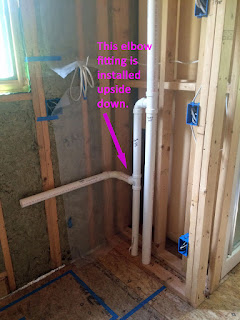As long as I've been working on this project--yes, many years--I have found it nearly impossible to hire trades people to do the plumbing and wiring on the JayBee. (Maine has a lack of people working in the trades and the ones we do have are booked solid for many months in advance with way bigger projects than mine.) Luck has been with me this year, thank goodness. Not sure why, since all the trades are more tightly booked this year than ever--even going out to 2023 in some cases. I'm just embracing the luck, though, and counting my blessings.
In mid November, I heard a rumor from some neighbors that a former state plumbing inspector lives nearby, is now retired, and takes on occasional plumbing jobs. When I called him, it turned out he had been the state plumbing inspector when I reported the plumber-thief years ago. I recognized his name, and he recognized my name and the case; that's small-town Maine for you! He was skeptical about working on a tiny house, but he agreed to stop by and see my project. After seeing it, he agreed to finish up my plumbing!
My new plumber wanted to change four things about the plumbing that had already been done. First, he pointed out that an elbow installed on the kitchen-sink drain line had been installed upside down. Note how it curves upwards instead of down. Makes me shake my head. That's why I hired out the plumbing--so it would be done right. I had not noticed this mistake.
Next, he didn't like that the drain line for the washer was going to put the p trap under the floor--making it susceptible to freezing. Third, we debated how to vent the washer. I didn't want another hole in the roof for a separate vent, and I didn't want a bunch of vent line cluttering up the loft as it snaked across to tie into the bathroom vent. The Code Enforcement Officer agreed that we could use an air activation valve on the washer--as long as it would be accessible in case it needed to be serviced down the road. Finally, the plumber didn't like that the water line to the outdoor faucet did not have its own shut-off valve.
The plumber was very excited after his first full day of work, so I stopped by after my work day to check it out. When I drove up, I saw a lot of plumbing supplies lying on the slab, but I didn't see that much work had been done.
When I got down on my knees, though, and looked up on the underside of the JayBee's floor, my jaw dropped. Even though I was fully aware of every plumbing fixture in the house, I just didn't envision how much piping was going to be required underneath the house. I'm sure glad I didn't try to figure out this maze by myself!
On subsequent days, the plumber fixed the drain line to the kitchen sink.
He ran water lines to the bathroom sink and toilet.
He ran water lines in and out of the water heater, and over to the washer. He also brought the water line up through the floor (missing the support beam for the trailer underneath) and over to the water heater.
Now the washer's p trap is above the floor (in the conditioned space), and the outdoor faucet has its own shut-off valve.
The washer is vented up the wall of the closet and is capped by an air activation valve (on top of the vent pipe).
The last bit the plumber did was wrap the water line under the house with heat tape and insulation.
There was no way not to have the p trap for the shower underneath the house, so I built a box around it to insulate it.
I loaded the box with insulation...
After I finished adding insulation to the box, I screwed its last side onto it.
The only plumbing things left to do are: connect the two sinks, install the toilet (flooring has to go down first), and turn the water on. I don't want to turn on the water until all the electrical boxes are live and functional, the house has functional heat, and I have the skirting installed around the outside of the house. I have my work cut out for me!
Also see:
Plumbing 1
Plumbing 2
One additional thing I've done recently: I hung this heater in the bathroom. It's installed higher on the wall than recommended--but it's the only place it would fit in the bathroom. I have an identical heater that will be installed in the living room--down at the height that it belongs. The two heaters, along with the electric radiant heat in the floor, should keep the JayBee nice and toasty!




















Great question, Cindy! I had been on track to move into the house before this winter...
ReplyDeletewhen disaster struck. The water line coming into the house (installed by a licensed plumber, not me) burst one night and filled the house with water. Inches of standing water throughout the house. All these things ended up getting torn out: the bottom two rows of boards on all the walls and the insulation behind them, the flooring and underlayment, the electric radiant heat in the floor, the subfloor, the radiant barrier and insulation under the floor. The house got dried out (finally) and treated to prevent mold, and I'm starting to rebuild. Such a disheartening and discouraging mess! 2022 just wasn't my year. I'm hoping to get it all done (again) this year, and move in over the summer. I guess I should add some posts to this blog at some point...